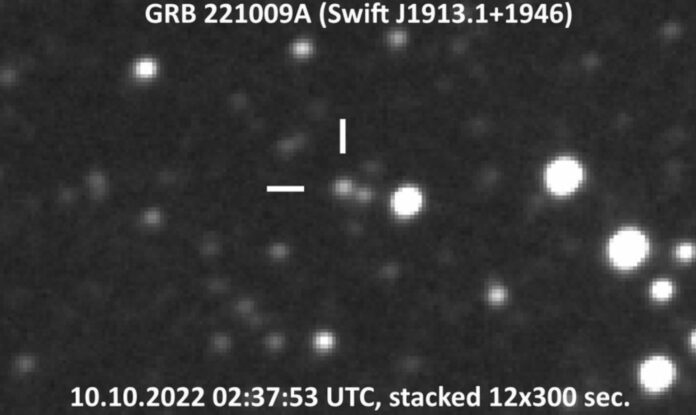BOAT Event: A new study reveals the mystery of the brightest cosmic explosion known as GRB 221009A ever witnessed.
Last year, on October 9, 2022, the cosmic stage was graced with an explosion of unparalleled intensity, earning it the name – Brightest of All Time (BOAT). Originating from the cataclysmic collapse of an immense star and the subsequent birth of a black hole, the event showcased an extraordinarily luminous gamma-ray burst, followed by a peculiarly slow-diminishing afterglow.
The captivating event of October 22 last year, renowned as the Brightest of All Time (BOAT), has riveted space scientists like few other cosmic explosions before it. This spectacular occurrence, which marked the collapse of a massive star and the birth of a new black hole, was observed as a breathtakingly bright burst of gamma rays, trailed by a gradually dimming afterglow spanning various frequencies.
Upon receiving the BOAT signal in unison through their colossal telescopes, astrophysicists from around the globe embarked on a fervent quest to comprehend the exceptional brightness of this gamma-ray burst (GRB) and the peculiar slow waning of its afterglow.
Dr. Hendrik Van Eerten, from the Department of Physics at the University of Bath in the UK, alongside a global team of scientists, has recently proffered an explanation: the initial burst, known as GRB 221009A, was directly angled towards Earth, bringing with it a significant volume of stellar material.
Today, the findings of this team are unveiled in the esteemed journal, Science Advances. The lead author of the study is Dr. Brendan O’Connor, a fresh PhD graduate from the University of Maryland and George Washington University in Washington, DC.
Dr. Van Eerten, one of the key figures in the theoretical analysis of the afterglow, pointed out that other scientists tackling this conundrum have reached a similar conclusion—that the jet was aimed precisely at us, much like a garden hose directed to spray straight at an object. This discovery substantially explains why the event was so brilliantly visible.
On 2022-10-10 I observed the optical afterglow of the extremely bright GRB 221009A = Swift J1913.1+1946 remotely using telescope of Burke-Gaffney Observatory @smubgobs.
— Филипп Романов/Filipp Romanov (@romanov_filipp) October 10, 2022
Image: stacked 12×300 sec., Ic filter.
More information: https://t.co/sjocA0PCOo@Astroguyz @El_Universo_Hoy pic.twitter.com/mSCKWZzkuI
Nevertheless, a perplexing mystery persisted—the edges of the jet remained completely invisible.
“The slow fade of the afterglow is not characteristic of a narrow jet of gas, and knowing this made us suspect there was an additional reason for the intensity of the explosion, and our mathematical models have borne this out.
“Our work clearly shows that the GRB had a unique structure, with observations gradually revealing a narrow jet embedded within a wider gas outflow where an isolated jet would normally be expected.”
How the Universe’s Brightest Cosmic Explosion Broke Records and Mystified Scientists
Dr. Van Eerten says: “GRB jets need to go through the collapsing star in which they are formed, and what we think made the difference in this case was the amount of mixing that happened between the stellar material and the jet, such that shock-heated gas kept appearing in our line of sight all the way up to the point that any characteristic jet signature would have been lost in the overall emission from the afterglow.
“Our model helps not just to understand the BOAT, but also previous brightness record holders that had astronomers mystified about their lack of jet signature. These GRBs, like other GRBs, must be directed straight towards us when they happen, as it would be unphysical for that much energy to be expelled in all directions at once.
“An exceptional class of events appears to exist that are both extreme and manage to mask the directed nature of their gas flow. Future study into the magnetic fields that launch the jet and into the massive stars that host them should help reveal why these GRBs are so rare.”
Dr O’Connor adds: “The exceptionally long GRB 221009A is the brightest GRB ever recorded and its afterglow is smashing all records at all wavelengths. Because this burst is so bright and also nearby (cosmically speaking: it occurred at the minor distance of 2.4 billion light years from Earth), we think this is a once-in-a-thousand-year opportunity to address some of the most fundamental questions regarding these explosions, from the formation of black holes to tests of dark matter models.”
Source: 10.1126/sciadv.adi1405
